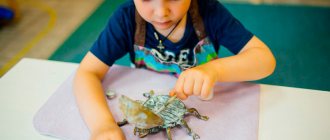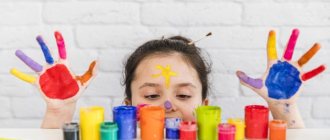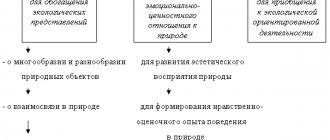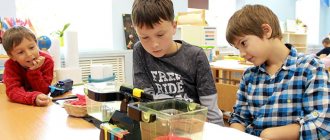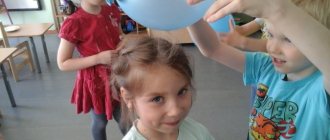Maria Montessori
Maria Montessori
Maria Montessori came to children's pedagogy through medical practice, in which for 10 years she taught mentally retarded children, including teaching reading, writing and arithmetic. In a psychiatric clinic, M. Montessori worked with her lover (they were never married) D. Montessano, who was also a doctor. There is a myth that Montessori abandoned her child, but this is not entirely true. In Catholic Italy of the last century, a child born out of wedlock was illegitimate. Such a situation could become a big problem in the lives of both parents, so the child was raised in the family of distant relatives of the husband in the village until the age of 10, and only after this time was he reunited with his mother.
In her methods of teaching mentally retarded children, Montessori adhered to the views of the French doctors Seguin and Itard, which were based on the development of sensory organs in sick children. She herself wrote about it this way:
“Ten years of my own work can in a sense be considered as a summing up of the forty years of work of Itard and Séguin.”
The Montessori method was originally created for children from 3 to 6 years old (the period of preschool childhood in Italy), but was later extended both up to 3 years old and throughout the entire school period. In Russia there are several Montessori schools with primary classes. In our review we will reveal the classic Montessori program for 3-6 years.
Philosophy of the Montessori method
Any development method is, first of all, the values of the author and his views on education. The exercises themselves are only means of achieving these values. The main goal that a child should achieve according to Montessori is to join adult society, mastering its inherent qualities.
“With us, a child learns to move, and not sit motionless in one place, he acquires behavioral skills not for school, but for future life, thanks to habit and practice, he learns to easily and correctly perform simple actions necessary for life in society.”
The Montessori method is based on accepting the nature of the child, who from birth acts as an inquisitive and free explorer who strives to actively explore the world and master skills. An adult should under no circumstances interfere with the child’s activity. As M. Montessori herself warns:
“We can only guess about the consequences of suppressing the child’s spontaneous actions during the period when he is just learning to be active: perhaps we are suppressing life itself in him... It is necessary to resolutely reject everything that interferes with the child’s spontaneous manifestations and forces him to do something. Of course, here we are not talking about useless and dangerous actions that should be stopped.”
The Montessori method provides an individual approach to the child, where he independently chooses his own activities and their duration, thus he develops at his own rhythm based on his own desires. Classes take place in a specially created Montessori environment, which mainly consists of didactic Montessori material (we will talk about this a little later).
What the Montessori environment does not have are heavy, fixed desks, which, in her opinion, “shackle the souls” of children, forcing them to study. There are also no grades or all kinds of encouragement from adults: treats, certificates, awards, etc. A child in a free environment acts based on his own interests and the interests of his development, and external rewards are only a mockery of his feelings and personality. Therefore, in this technique there are no rewards from other people, but there is pleasure from independently satisfying your desires.
Many parents think that Montessori development means providing the child with Montessori materials and leaving him alone. But Montessori is, first of all, a free child and an observant adult. How many parents are ready to give their child freedom and make an effort not to take it away? And also just monitor the child’s activities without teaching or interfering with it?
Pros and cons of the technique
When considering the Montessori method, there are several main disadvantages that critics mention:
- After learning under this system, it may be difficult for a child to fit into the school community and follow the rules. This is due to the fact that the Montessori method implies free movement around the classroom and independent choice of activities.
- Groups of different ages. According to educators who criticize Montessori theory, elders will always dominate and suppress younger ones who interfere with them.
- Refusal of fairy tales and poems. Maria Montessori considered fairy tales useless, since they only teach to escape from reality into fantasy.
- Distraction from social reality. Kindergarten students learn to do what they want and some of them rarely work in a team. Moreover, the methodology involves the use of too many objects that create an artificial environment, which is why adaptation problems may arise when studying in primary school.
Note! But the advantages can overshadow the disadvantages of the system. The main advantage is that the child gets used to learning independently and constantly strives for development. In this case, the child is not criticized, and punishments are completely excluded. The Montessori method teaches order and respect for others from early childhood.
Lesson in a Montessori classroom
Another advantage of the system is that students begin to write and read earlier. At the same time, teachers apply an individual approach to each child, taking into account his abilities and needs.
Interesting! To work with this system, a teacher can take a short training course.
Another advantage is the formation of groups not by age, but by interests. This increases interest in the learning process itself. The technique also implies the development of independence and the ability to make decisions. Despite all the pros and cons of the Montessori system, this approach encourages students to engage in self-development of their own free will, and not under compulsion.
Drawing lesson on the topic “Who do you want to be” in preparatory groups
Freedom of the child and the role of the educator
By the role of a teacher we will understand not only employees of child care institutions, but also the child’s parents and other adults who decided to use this method.
Montessori invites the teacher to master the consciousness of a scientist. Take on a more specialized role as an observer of the child (like a scientist in a laboratory observing microorganisms through a microscope) rather than simply monitoring his safety and assigning tasks.
“I firmly believe that we should cultivate in our teachers the spirit of a scientist, and not instill in them the skills of mechanical work.”
The teacher's task is to meaningfully monitor the child. The teacher should not impose knowledge or purposefully teach the child. He can sometimes only slightly direct the child’s actions (without nevertheless allowing him to feel his presence). And he can help only at the request of the child himself.
"Wait and watch." This is the motto of the teacher. Let's wait and be always ready to share with the child his successes and difficulties. He himself will ask us for help, and then we will have to respond joyfully. Let us be patient as we watch his slow progress. And we will show joy and enthusiasm when the child wants to share his successes with us. If we could say, “We have respect and interest in the actions of our children, we treat them as we would like to be treated,” then we would certainly understand the great principle of education and would undoubtedly become a model good teachers."
The child himself is given the task of being free and doing whatever he wants in the environment, without disturbing other children. But even so, the teacher should not be a passive observer, but should be an active scientist:
“The freedom of the child must have a limitation, the criterion of which is the collective and its interests, and a form that is commonly called good upbringing. To do this, you need to study each child individually, finding out what in his behavior can cause offense and irritation to others, and what inclinations can subsequently lead to rude behavior. In all other respects - in all manifestations that have some benefit - whatever they may be and whatever form they are expressed in - everything should be allowed, but with mandatory supervision from the teacher.”
In such a free environment, the child learns and develops independently, through Montessori materials (parents call them “Montessori toys”), which contain self-learning functions.
The classic Montessori group consists of children from 2 years 8 months to 6 years. All children study in the same group, not separated by age. This is a good solution, since the younger ones learn from the older ones, take from them examples of behavior, actions with objects, etc.; and the elders learn to teach the younger ones, showing sensitivity and care, they take on the role of leader and mentor. This interaction helps establish a friendly atmosphere in the group.
Independence
In addition to freedom, Montessori places great emphasis on independence and calls for giving children the opportunity to do independently everything that they can do:
“Our duty towards the child is to help him independently master useful skills provided by nature itself. A bad mother is one who feeds her child from a spoon and does not make the slightest effort to teach him to hold the spoon independently or bring it to his mouth, and who does not even eat herself in front of the child so that he can see how it is done. Such a mother insults the human dignity of her baby - she treats him like a doll, and not a person entrusted by nature to her care.”
When a child acts independently, his internal forces are freed, which gives him not only autonomy from parents and adults, but also the opportunity to independently explore the world.
The developing Montessori environment is also aimed at developing independence through the following actions:
- Self-care (for example, getting dressed, eating, or bringing yourself water for drawing);
- Personal hygiene and toilet;
- Maintaining cleanliness and order, etc.
All Montessori materials (“Montessori toys”) are intended for independent use.
Games based on the Montessori method for sensory development
Sensory activities are very exciting for the kids. One of these games is a bag, in which they must identify the object by touch. This causes great delight in the kids as soon as they guess.
For Montessori games, DIY materials may include making sound cylinders. They are made from any containers or boxes that can be filled with cereals, pebbles, and coins. Such items develop hearing acuity in children.
Note! Finger painting is considered one of the most exciting activities. During its implementation, the baby can develop fine motor skills, imagination and curiosity.
Fun drawing
Hygiene
Much attention in Montessori pedagogy is paid to hygiene. This is due to the fact that “Children’s Houses” (kindergarten for residents of apartment buildings) were opened, although in rebuilt, but in the poorest areas of Rome, where the low strata of society lived, crime, debauchery and violence reigned, and in an apartment they could live up to 20-30 people and there was water only a few hours a day. In his main book, “My Method,” Montessori describes these areas at length, but we will limit ourselves to just one phrase:
“Where in the dark no one risks going out without a weapon.”
In such an area, after some “renovation”, the first “Children’s Home” opened. When organizing it, the issue of hygiene became a big problem. Therefore, the first and main rule of this institution was:
“Mothers are obliged to send their children to the orphanage clean.”
Thus, due to social problems, one of the main provisions of Montessori pedagogy appeared.
From the first visit to kindergarten, a child learns to wash his hands and clean his nails, clean up after himself, etc. All this leads to the fact that the child monitors his appearance, actions in every possible way and tries to behave carefully.
Montessori exercises: developing fine motor skills
The development of fine motor skills in early and middle age is one of the important areas of pedagogical activity. Playing with laces is a great way to develop fine motor skills. You can use a wooden shoe sample or draw it on cardboard.
For girls, you can offer a game with beads of different shapes and sizes. They will string them on laces. It is important that both beads and laces are multi-colored.
Note! The most accessible material for Montessori games is paper. Children develop motor skills by cutting out stripes, figures, and various patterns.
Fine motor skills activities
Lessons in Silence
As we have already said, in a Montessori environment there are no heavy or fixed desks. Instead, lightweight desks and chairs are offered that move easily and make sound. But this is not done for the sake of creating noise, but just the opposite. A Montessori garden is a quiet place where every child is enthusiastically busy with their work. And when a child, getting up from the table, makes noise, it distracts other children, they pay attention to the silence breaker. The child who made the noise finds such attention unpleasant, and next time he tries to do it as quietly as possible so as not to disturb other children. All this develops not only grace and skill in getting up from the table unnoticed (and also walking quietly), but most importantly it makes you aware of the value of other people’s feelings, which are so easy to interfere with and disrupt their concentration.
In addition, M. Montessori developed special silence lessons, where children learn to control their behavior and be more organized. For example, one of the silence lessons goes like this: the teacher leaves the children alone, and she goes into another room and from there, in a barely audible whisper, calls one of the children by name. The child’s task is to hear his name and get up very quietly, without making noise, and go to the teacher in another room.
Montessori environment
A Montessori garden is divided into a number of zones in which the child can freely spend time and study. Each zone contains Montessori material - a didactic tool created specifically for each zone and aimed at developing certain qualities and abilities in the child.
1. Practical Life Exercises . In this zone the child develops skills:
- Personal care (dressing, washing, cooking, cleaning).
- Caring for the environment (caring for plants and animals).
- Movement skills (line walking, silence and grace exercises).
- Social skills (communication and manners).
- Sometimes modeling, classes with clay and a potter's wheel are added.
2. Zone of sensory development . With the help of Montessori materials, a child develops his senses - vision, hearing, smell, touch, taste. This is the main zone, according to M. Montessori, for the development of a child, as he learns the world with the help of his senses.
The materials highlight mainly one sign (for example, the feeling of the mass of an object), and the child learns to concentrate only on it, isolating other senses (children may have their eyes covered with a blindfold). This concentration helps the child understand the main difference between objects and learn this quality, for example, that objects are heavier or lighter. All this is aimed not only at developing the accuracy of discrimination, but also at understanding the logical connections between objects.
Touch zone materials:
To determine the size - cylinder blocks, towers, stairs, red bars, geometric shapes.
To develop the tactile sense - rough plates and various fabrics.
To distinguish colors - color plates with 64 shades. Montessori used “muted” colors in her methodology (unlike mass toy manufacturers), which are calmer and introduce a more refined taste.
For hearing development - noise cylinders and bells.
To develop the stereognostic sense (sense of the shape of an object) - geometric bodies, a magic bag (a bag with various objects to be identified by touch), sorting, bars of different weights.
To develop the sense of smell - sets of jars with oils, bags with different herbs, spices, etc. for inhaling and distinguishing aromas.
To develop taste - “taste bottles”, a set of bottles with pipettes, each with its own taste (bitter, sweet, sour, salty). The child tries each taste in turn.
3. Zone of mathematical development . The foundation is built on sensory material, which is very good because the child does not have to abstractly comprehend the concept of numbers. This makes it easier for your child to understand numbers and mathematical operations.
Materials used:
For counting within 10 - number bars, number plates (rough and tactile), spindles.
For getting acquainted with multi-digit numbers, this is the “golden” material.
For counting up to 100 - beads, Segan boards, colored chains.
To get acquainted with arithmetic operations - stamps, dot games, addition, subtraction, multiplication and division tables.
And a few others for understanding fractions and geometric figures.
4. Native language zone . Here children learn to read and write through tactile materials, making learning easier.
Materials:
Expansion of vocabulary - cards depicting objects.
For teaching writing - frames for shading, rough letters, outlines of letters, movable alphabet.
For learning to read - boxes with figures, captions for environmental objects.
We'll talk more about reading and writing below.
These are 4 classic Montessori zones created by the author himself. In addition to them, you can find a “space education zone”, in which children are encouraged to study the world around them. As a rule, training takes place on specific material, sometimes with demonstrations by the teacher. The materials include various tables, cards, maps, diagrams, calendars, experimental sets, etc., on the topic: geography, biology, history, science.
We have provided photographs of only part of the material for your reference.
Development of children's cognitive abilities through teaching materials from Maria Montessori
"Development of children's cognitive abilities through
didactic materials by Maria Montes c ori"
G.S. Lukhmanova
Educator, GKKP "Nursery-garden No. 115", Pavlodar
The M. Montessori system, which is based on special didactic materials for child development, is a recognized pedagogical system throughout the world. The main point of this technique is to develop the child’s cognitive abilities. The combination of a special subject environment and special forms of organization, based on individual children's interest, leads to significant achievements in the development of the child. Children exhibit internal changes, which are expressed in “...balance, free expression of oneself, the ability to build relationships with others, take into account their interests, empathy, as well as emotional responsiveness to beauty and active cognitive interest” (M. Montessori)
The basis of Montessori pedagogy, its motto is “Help me do it myself!” The Montessori method is based on a reasonable balance between freedom and clear structure, specifically designed for the young child. M. Montessori developed didactic games and various aids to improve the visual, auditory and tactile perception of children. The ideas and manuals proposed by famous scientists I. Itard and E. Seguin were taken as a basis. Exercises for developing fine motor skills - stringing beads, pouring water, pouring cereals, sorting legumes and many more interesting tasks, games and exercises. M. Montessori involves children in activities that are interesting to them, provides carefully developed didactic Montessori materials, Montessori manuals that correspond to the natural needs of the child. In order for a child to fully develop, he needs an environment that allows him to fully utilize all the capabilities of a growing person, satisfies the child’s need for spontaneous activity, provides food for the mind and does not hinder movement. It must correspond to the age and sensitive capabilities and needs of the child, be strictly ordered, accessible and understandable. All work according to the Montessori system is built according to a specific plan, with a transition from one stage to another, from one zone to another, and with strict adherence to this sequence. To create such an environment, Montessori materials and other specially selected objects and aids that meet didactic, aesthetic and environmental requirements are often used. Montessori materials are child development tools selected by Maria Montessori as a result of her observations of children. All materials are ordered by degree of difficulty and are freely available to the child on low tables and shelves. The main task is to stimulate the individual development of the child. In the course of working (playing) with the material, certain psychological qualities are formed in the child, and internal motivation for learning develops. Materials and their functions must be considered in relation to Maria Montessori's vision of the child, namely his anthropology. She saw in the developing child powerful internal creative forces that do the work of developing and building his own personality. At the same time, the materials significantly help to organize the child’s comprehension of the world around him. The teacher’s focus is on the child with his individual and social-emotional needs, while the materials play an auxiliary didactic role. Didactic materials serve primarily to contribute to the spiritual development of the child through the age-appropriate development of his motor skills and sensory skills. The child acts independently, his internal forces are freed so that gradually, step by step, he can become independent of adults. Individual and social development form a unity of opposites. Only it makes it possible for an autonomous and independent person to implement complex behavior in society. For a child, Montessori materials are the key to the world, thanks to which he organizes and learns to understand his chaotic and unprocessed impressions of the world. With their help, the child grows into culture and modern civilization. How can we explain the fact that people are now increasingly turning to the experience of Maria Montenssori? It turns out that most modern children have a general motor lag, especially urban children. Even 20 years ago, parents, and with them their children, had to do more with their hands: sort through cereals, wash clothes, knit, embroider. Now there is a car for each lesson. A consequence of poor development of general motor skills, and in particular the hands, is the general unpreparedness of most modern children for writing or problems with speech development. With a high degree of probability we can conclude that if everything is not in order with speech, it is probably problems with motor skills. Unfortunately, most parents learn about problems with coordination of movements and fine motor skills only before school. This results in an increased burden on the child: in addition to learning new information, he also has to learn to hold a pencil in his unruly fingers.
Through independent handling of material, the child acquires various skills. He learns to set a goal and find appropriate ways to achieve it. Montessori materials respond to the child's spontaneous and insatiable desire for movement. Motor skills aimed at didactic purposes influence general, emotional, speech and social development. Through the strong attractiveness of materials, the child acquires interest in the thing. Out of curiosity and the joy of communicating with the material, he develops internal motivation that helps him comprehend the world. He strives to figure everything out on his own and needs only a little help from a teacher who observes his development and indirectly guides him, as far as necessary. Montessori materials promote “polarization of attention”
aimed at identifying the deep, internal connection between objects.
It occurs during the repetition of exercises. In this way, deep insight into the essence of the voluntarily chosen activity is achieved. To promote a child's independence from adults, Montessori materials provide the child with control over mistakes. The child must be able to find his own mistakes and correct them. If an error occurs, he eliminates it and the disrupted order is restored. This teaches precision and efficiency. Montessori materials are a cross between teaching aids and educational games, made from natural materials. The design of Montessori materials has not changed since their creation, i.e. almost 100 years. Valuable types of wood are used for the manufacture of wooden materials; all materials are made of very high quality, some of them are quite difficult to manufacture. That's why real Montessori materials are expensive. List of some materials and activities used in Montessori groups: Sensory development
Frames with clasps
- teaching specific skills necessary when dressing. Children are offered frames with buttons, snaps, zippers, buckles, laces, hooks, pins and bows.
Brown staircase
- presents the differences between two dimensions and introduces the concepts: thin, thinner, thinnest; thick, thicker, thickest.
Pink Tower
- represents differences in size in three dimensions and helps the child differentiate the concepts big, bigger, biggest; small, smaller, smallest.
Red bars
- represent differences in magnitude in one dimension (length) and introduce the concepts: short, shorter, shortest; long, longer, longest.
Cylinder blocks
- are four sets with nine cylinders each.
The first set consists of cylinders of different heights; the second - cylinders of different diameters; the other two include cylinders of different heights and diameters. Matching the cylinder to the appropriate hole helps in distinguishing size and develops the fine muscles of the hands necessary for writing. Colored Cylinders
- Each set corresponds to the size parameters of one of the sets of cylinder blocks.
Noise Cylinders
- This set consists of two wooden boxes, each containing six cylinders. Each pair of cylinders has its own sound, i.e. For each sound of red cylinders, a corresponding sound of blue cylinders is selected.
Speech development
Letters cut from sandpaper allow the child to recognize the outline of each letter through touch and associate the sound of the letter with its outline. Metal tabs - ten mathematical tabs of different geometric shapes. The tabs have a small handle for holding and moving. Tracing the outline of the tab helps prepare the hand and eye for writing.
Mathematical development
Red and blue bars
- a set of 10 rods of the same size as the red rods, but each rod is divided into red and blue parts. These exercises teach the basic principles of counting and can be used for simple addition, subtraction, multiplication and division.
Box with spindles
- two boxes with sections from 0 to 9 are used to teach counting and the concept of quantity. The child places a certain number of spindles in the appropriate section.
Gold beads
- These materials provide an introduction to the concepts of counting, quantity, and basic mathematical functions.
Geometric bodies
- teach visual and tactile discrimination of geometric shapes. The set consists of a cube, a sphere, a cylinder, a quadrangular pyramid, a rectangular prism, an ellipsoid, an ovoid, a cone and a triangular prism.
All of the above materials are difficult to use for teaching a child at home - they are designed for equipment in kindergartens and Montessori groups. At home, Montessori materials can only be used in limited quantities. As a rule, these are benefits such as:
- Geometric Montessori Insert Frames
- Educational frames
- Laces
- Toys with clasps
- Craft kits
- Visual aids to familiarize yourself with the world around you
Montessori pedagogy is based on treating the child as a free, developing, unique individual with his own plan and time frame for learning about the social environment and the objective world. Therefore, today the Montessori system is one of the most popular methods of early childhood development for teachers and parents.
Bibliography:
- The Big Book of Montessori / Daria Orlova. - SPb.: prime - EURO-ZNAK; Vladimir: VKT, 2009.-185, [7] p.: ill.- (Parent’s General Ledger)
- Preschool teacher, No. 5/2009, “Children’s space in pedagogy
M. Montessori" Rantz S.N., p. 128
To the regional scientific and practical conference
"V Capenov Pedagogical Readings"
REGISTRATION FORM
- FULL NAME. : Lukhmanova Gulmira Salmenovna
- Academic degree, title -
- Organization, position: GKKP "Nursery-garden No. 115", teacher
- Section Current issues in teaching disciplines of physics, mathematics, science and the humanities
The topic of the report is “Development of children’s cognitive abilities through didactic materials by M. Montessori”
- Home address: Tselinnaya 83-5, 62-08-68
I intend:
participate in absentia
Montessori material
You may have seen some of the Montessori material already above in the Montessori environment section.
Montessori's didactic material was not created from scratch, partly it is the developments of the “Gifts of Froebel”, already known for 200 years (Froebel is a German teacher, founder of the first kindergarten in 1836), partly it is the methods of Seguin and Itard. Montessori refines their material and also creates his own.
The material is made mainly from wood and other natural materials. Each group is allocated one or two copies of each type of Montessori material, which can cause some indignation in children. Children are not allowed to interfere with another child who is already working with a set, and therefore have to wait for him to become free (but the child usually does not wait, but takes another set). Upon completion of actions with the set, the child must independently fold it and take it to the shelf, only after that the set is available to other children. This is how the Montessori environment develops in children patience, discipline and a sense of the personal boundaries of other people.
The peculiarity of Montessori material is the built-in control function when operating the tool, when the child himself sees his mistakes. This is an important element in this system. For example, a block with cylinders. If the child places the cylinders incorrectly, some will be too deep in the hole, and some will rise above the border level.
The principle of Montessori materials can be partially transferred to many household items at home (but they will not have a control function): jars with lids, boxes, fasteners, clothespins, various gifts of nature (pebbles, sand, acorns), foods (cereals, pasta , beans) and so on. All this is available to the child at home, with the proper approach of the parents.
It is also worth considering that in a Montessori environment, all material is located on open shelves and chests of drawers, no higher than the child’s eye level, so that he can calmly and at any time come up and take it.
Montessori games for early development: small objects
Transferring small objects (coins, beads, pebbles) from one vessel to another using tongs or a spatula is a rather difficult task for small fingers. But it develops the child’s fine motor skills well.
Tests for preparing preschool children 6-7 years old for school at home
Beans, buckwheat, rice and other cereals are also good for playing with small objects.
Sensory development
Reading and writing
M. Montessori proposed teaching children to read through writing. Only after mastering writing do children learn to read on their own. Learning to write mainly comes down to tracing the outline of letter shapes and feeling them (vowels and consonants are covered with different materials and colors). This is how the child learns and remembers capital letters. Having studied a certain number of letters, the child tries to form words from them. Words in Italian (as in Russian) are read the same way they are written, i.e. Each letter has its own specific sound. Having composed a word from several familiar letters, a child can easily read it. Therefore, learning to read after mastering writing is not difficult for a child.
No one specifically sits a child down and teaches him to write letters, or forces him to cram. The child learns to write of his own free will, which is a distinctive feature of this method.
However, reading according to Montessori (from 3-4 years old) can lead to the same result as in other early learning methods - reading does not translate into understanding. Children do not understand the meaning of what they read. Reading is only a mechanical reproduction of sounds, but the child’s “head” not only does not retain the knowledge of what he has read, but it is not even imagined. M. Montessori herself writes about this:
“Phrase reading games. When friends learned that my children could already read print, they gave us beautifully illustrated books. After looking through these books with simple fairy tales, I became convinced that our students are not yet able to understand them. The teachers, on the contrary, were so proud of the successes of their students that they tried to convince me and forced the children to read aloud in front of me, while claiming that they read much better than second-grade elementary school students.
But I did not let myself be deceived and conducted two experiments. I asked the teacher to read one of these fairy tales to the children, and at the same time I observed how interested the children were in it. After just a few sentences, the children's interest waned. I forbade the teacher from calling those who were not listening to order, and gradually the class was filled with noise: the children, who were not interested in listening to the story, returned to their previous activities.
It was obvious that the children who, it seemed to us, read these books with such pleasure, were not at all interested in the content, but only in the mechanical skill that they had mastered and which consisted of translating graphic signs into the sounds of words they recognized. In addition, they read books with much less consistency than word cards, since they encountered too many unfamiliar words in the books...
I gave the child a book, sat down in a friendly manner next to him, and when he finished reading, I simply and calmly asked him, like a friend: “Did you understand what you read?” - to which he replied: “No.” It was clear from the expression on his face that he didn’t even understand why I was asking this.”
This is not a problem with the Montessori method itself, it is a problem with all too early methods of teaching reading. Therefore, parents do not need to run ahead of the child’s brain development and force him to learn to read before his organic abilities. Early learning to read can be harmful to a child; he will learn to read incorrectly and will have to relearn, which is much more difficult than learning from scratch, but at a more appropriate age.
